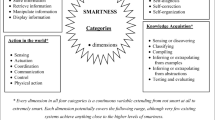Abstract
This article portrays the area of smart environments from a research perspective, defining the field and discriminating it against related fields. We position the field of smart environments within the disciplines of artificial intelligence and human-computer interaction and discuss its genuine research questions. As an application area, smart environments presents prospects on improving our everyday lives, but systems penetrating our environments also trigger crucial questions related to sociology, ethics, and privacy on an unprecedented level.


Similar content being viewed by others
References
Aarts E (2009) New research perspectives on ambient intelligence. J Ambient Intell Smart Environ 1:5–14
Acampora Giovanni, Cook Diane J, Rashidi Parisa, Vasilakos Athanasios V (2013) A survey on ambient intelligence in health care. Proc IEEE 101:2470–2494
Ariely Dan (2008) Predictably irrational: the hidden forces that shape our decisions. Harper, New York
Benini Luca, Farella Elisabetta, Guiducci Carlotta (2006) Sensor networks for ambient intelligence. Microelectr J 37(12):1639–1649
Bohn J, Coroamă V, Langheinrich M, Mattern F, Rohs M (2005) Social, economic, and ethical implications of ambient intelligence and ubiquitous computing. Ambient Intell. Springer, pp 5–29
Boudette NE (2017) Tesla’s self-driving system cleared in deadly crash. The New York Times, 19 Jan 2017
Brey Philip (2006) Freedom and privacy in ambient intelligence. Ethics Inf Technol 7(3):157–166
Browne D, Totterdell P, Norman M (eds) (1990) Adaptive user interfaces. Academic Press Ltd, London
Compton M, Henson CA, Neuhaus H, Lefort L, Sheth AP (2009) A survey of the semantic specification of sensors. In: Proceedings of the 2nd international workshop on semantic sensor networks (SSN09), collocated with the 8th international semantic web conference (ISWC-2009), Washington DC, pp 17–32
Cook Diane J, Augusto Juan C, Jakkula Vikramaditya R (2009) Ambient intelligence: technologies, applications, and opportunities. Pervasive Mob Comput 5:277–298
Cook DJ, Das SK (2007) How smart are our environments? An updated look at the state of the art. Pervasive Mob Comput 3:53–73
Coradeschi S, Saffiotti A (2006) Symbiotic robotic systems: humans, robots, and smart environments. IEEE Intell Syst 21:82–84
Dee HM, Hogg DC (2009) Navigational strategies in behaviour modelling. Artif Intell 173:329–342
Forbus KD (1984) Qualitative process theory. Artif Intell 24(1–3):85–168
García-Herranz Manuel, Haya Pablo, Alamán Xavier (2010) Towards a ubiquitous end-user programming system for smart spaces. J Univers Comput Sci 16:1633–1649
Gigerenzer Gerd, Gaissmaier Wolfgang (2011) Heuristic decision making. Annu Rev Psychol 62:451–482
Jaschinski C, Allouch SB (2015) An extended view on benefits and barriers of ambient assisted living solutions. Int J Adv Life Sci 7
Kahneman Daniel (2011) Thinking. Fast and Slow. Farrar, Straus and Giroux, New York City (NY), USA
Lucke D, Constantinescu C, Westkämper E (2008) Smart factory—a step towards the next generation of manufacturing. In: Mitsuishi M, Ueda K, Kimura F (eds) Manufacturing systems and technologies for the new frontier. Proceedings of the 41st CIRP conference on manufacturing systems, Tokyo, 26–28 May 2008. Springer
Matfield K. Bridging the gap between actual and reported behavior. http://www.uxbooth.com/articles/bridging-the-gap-between-actual-and-reported-behavior/. Accessed May 2015
Moore GE (1965) Cramming more components onto integrated circuits. Electronics 38:114–117
Nisbett RE, Wilson TD (1977) Telling more than we can know: verbal reports on mental processes. Psychol Rev 84(3)
Don Norman. The Design of Future Things. Basic Books, 2007
Pauwels E, Salah AA, Tavenard R (2007) Sensor networks for ambient intelligence. In: Proceedings of IEEE workshop on multimedia signal processing, Chania
Russell Stuart, Norvig Peter (2009) Artificial intelligence: a modern approach, 3rd edn. Prentice Hall Press, Upper Saddle River
Sadri F (2011) Ambient intelligence: a survey. ACM Comput Surveys 43:36
Shapiro D, Augusto JC, Ramos C (2008) Ambient intelligence—the next step for artificial intelligence. IEEE Intell Syst 23(2):15–18 (guest editors’ introduction)
Tversky Amos, Shafir Eldar (1992) The disjunction effect in choice under uncertainty. Psychol Sci 3(5):305–310
Winograd Terry (2006) Shifting viewpoints: artificial intelligence and human–computer interaction. Artif Intell 170(18):1256–1258
Youngblood GM, Heierman EO, Holder LB, Cook DJ (2005) Automation intelligence for the smart environment. In: Proceedings of the international joint conference on artificial intelligence
Acknowledgements
Diedrich Wolter acknowledges financial support by Technologieallianz Oberfranken (TAO).
Author information
Authors and Affiliations
Corresponding author
Rights and permissions
About this article
Cite this article
Wolter, D., Kirsch, A. Smart Environments: What is it and Why Should We Care?. Künstl Intell 31, 231–237 (2017). https://doi.org/10.1007/s13218-017-0498-4
Received:
Accepted:
Published:
Issue Date:
DOI: https://doi.org/10.1007/s13218-017-0498-4




